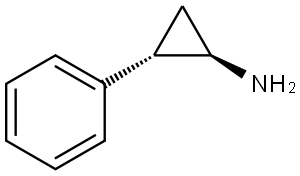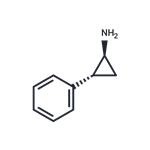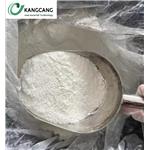ChEBI: (1R,2S)-tranylcypromine is a 2-phenylcyclopropan-1-amine that is the (1R,2S)-enantiomer of tranylcypromine. It is a conjugate base of a (1R,2S)-tranylcypromine(1+). It is an enantiomer of a (1S,2R)-tranylcypromine.
A solution containing 167 grams of stabilized styrene and 183 grams of ethyl
diazoacetate is cooled to 0°C and dropped into 83.5 grams of styrene with
stirring, in a dry nitrogen atmosphere, at 125° to 135°C. This produced the
ester ethyl 2-phenylcyclopropanecarboxylate.
A solution of the above ester (207.8 grams) and 64.5 grams of sodium
hydroxide in 80 cc of water and 600 cc of ethanol is refluxed for 9 hours. The
carboxylic acid of 2-phenylcyclopropane is liberated with 200 cc of
concentrated hydrochloric acid. The 2-phenylcyclopropanecarboxylic acid
contains 3 to 4 parts of the trans isomer to 1 part of the cis isomer. The acid
is recrystallized from hot water. The pure trans isomer comes out as
crystalline material (solid) while the cis isomer stays in solution.
A solution of 4.62 grams of 2-phenylcyclopropanecarboxylic acid in 15 cc of
dry benzene is refluxed with 4 cc of thionyl chloride for 5 hours, the volatile
liquids are removed and the residue once more distilled with benzene.
Fractionation of the residue yields the carbonyl chloride of 2-
phenylcyclopropane.
A mixture of 15 grams of technical sodium azide and 50 cc of dry toluene is
stirred and warmed and a solution of 10 grams of 2-
phenylcyclopropanecarbonyl chloride in 50 cc of dry toluene is added slowly.
Inorganic salts are filtered and washed well with dry benzene and the solvents
are removed under reduced pressure. The RCON3 compound produced
undergoes the Curtius rearrangement to RNCO + N2. The residual isocyanate
is a clear red oil of characteristic odor. It is cooled to 10°C and treated
cautiously with 100 cc of 35% hydrochloric acid whereupon RNCO + H2O gives
RNH2 + CO2.After most of the evolution of carbon dioxide has subsided the
mixture is refluxed for 13 hours, the cooled solution is diluted with 75 cc of
water and extracted with three 50 cc portions of ether. The acid solution is
evaporated under reduced pressure with occasional additions of toluene to
reduce foaming.
The almost dry residue is cooled to 0°C and made strongly alkaline with a
50% potassium hydroxide solution. The amine is extracted into several
portions of ether, dried over potassium hydroxide, the solvent removed, and
the base fractioned. Reaction of the base with a half-molar quantity of sulfuric
acid gives the sulfate.
Cuait;Estelapar;Jatrosom;Oculocidon;Parnate tylciprine;Parnetene;Parstelazin;Parstelin;Transaminase sgo;Transaminase sgp.
World Health Organization (WHO)
Tranylcypromine, a monoamine oxidase inhibitor (MAOI), was
introduced in 1961 for the treatment of depressive illness. By 1964 its use had been
associated with transient hypertensive crises and other adverse effects when taken
together with certain cheeses and other foods containing tyramine. This led to the
withdrawal of the drug in several countries and the suspension of marketing on a
worldwide basis by the major manufacturer pending review of these adverse
reactions. Subsequently, in response to requests from the medical profession,
tranylcypromine was resubmitted for registration with appropriate warnings in the
product information and it is now marketed in more than 30 countries.


